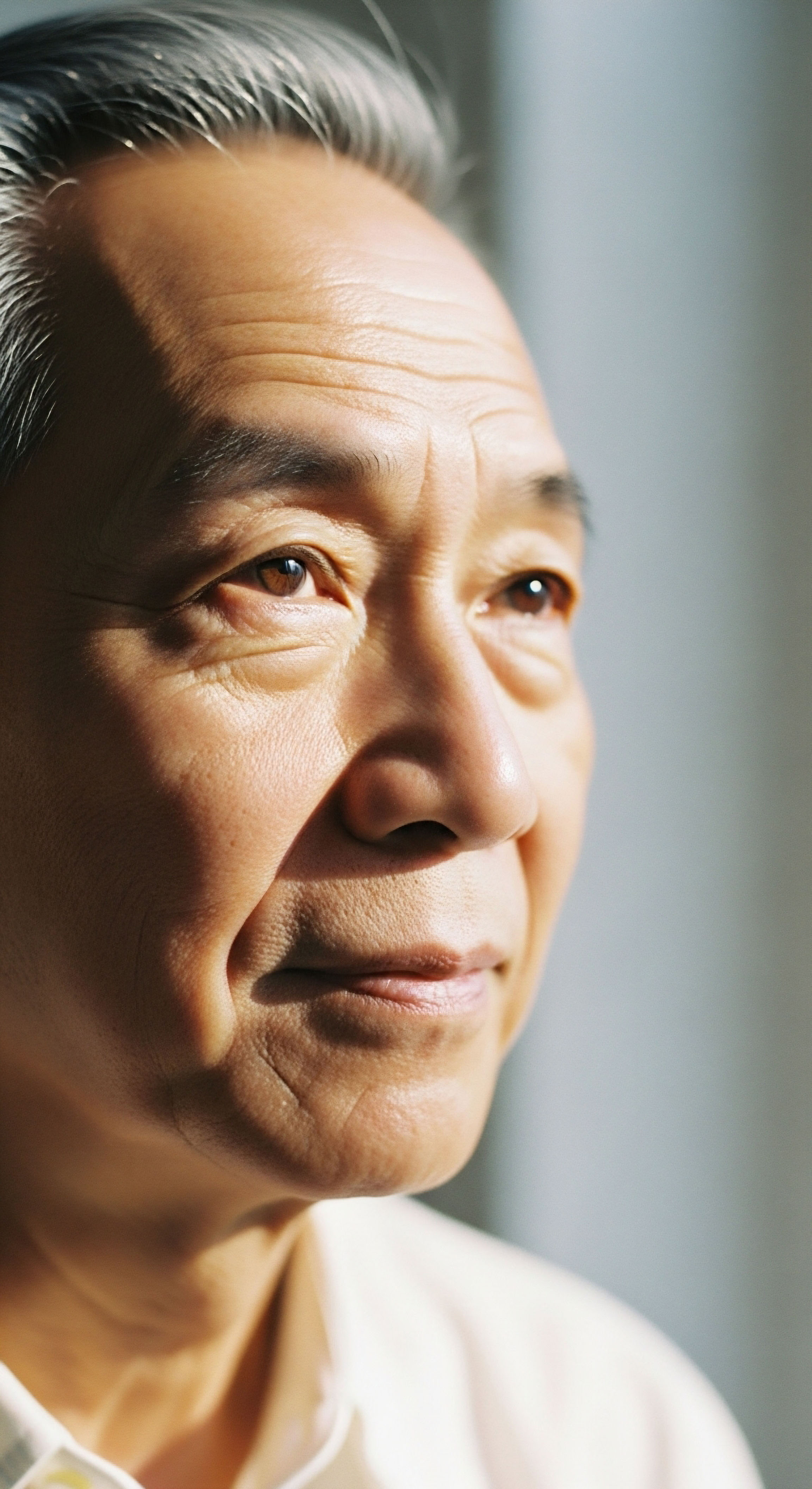

Fundamentals
The sensation of tenderness following an injection is a direct communication from your body. It is a localized, intelligent response to a specific event ∞ the introduction of a therapeutic substance through the skin and into the muscle or subcutaneous tissue.
Your experience of this tenderness is entirely valid, representing a normal physiological process that we can learn to manage with precision and understanding. When a needle pierces the skin, it creates a microscopic channel, and the fluid administered gently displaces the surrounding cells. This physical event alone is enough to signal your body’s innate protective systems.
Your immune system, ever vigilant, immediately registers this event. Specialized cells are dispatched to the site to assess the situation. This results in a controlled inflammatory response, characterized by the familiar signs of redness, warmth, swelling, and tenderness. This process is fundamental to healing and protection.
The fluid itself, whether it’s a hormone in a carrier oil or a delicate peptide in bacteriostatic water, occupies space, creating temporary pressure on nerve endings and muscle fibers. Our goal is to support the body through this initial phase, ensuring the therapeutic agent is absorbed efficiently while minimizing the associated discomfort.
Post-injection tenderness is a normal, localized immune response to the physical administration of a therapeutic substance.

Understanding the Initial Physical Response
The moment of injection initiates a cascade of events at the cellular level. The needle, regardless of its fineness, causes a minor mechanical disruption to the tissue architecture. Muscle fibers, if it is an intramuscular injection, are parted. The volume of the medication then creates a small deposit, or bolus, within the tissue.
This fluid pressure is a primary source of the initial ache. Your body responds by increasing blood flow to the area, which brings immune cells and fluid, contributing to swelling but also beginning the process of dispersing and absorbing the medication.
Simple, immediate actions can significantly influence this process. Gentle movement of the injected limb, for instance, encourages circulation. This increased blood flow helps to distribute the medication from the localized deposit into the wider circulatory system, relieving pressure and accelerating absorption. The application of a cold pack is another effective strategy. Cold temperatures cause local blood vessels to constrict, which can limit the initial inflammatory cascade and numb superficial nerve endings, providing direct relief from soreness.

How Can Site Selection Influence Comfort?
The location you choose for an injection has a profound impact on subsequent comfort levels. Different areas of the body have varying amounts of muscle mass, fatty tissue, and proximity to nerves. For intramuscular injections, such as Testosterone Cypionate, selecting a large, deep muscle is paramount.
The gluteal or ventrogluteal muscles (in the buttocks and hip) and the vastus lateralis (in the thigh) are ideal because they can accommodate the volume of the injection with less mechanical strain. Injecting into a smaller muscle, like the deltoid in the shoulder, with too much volume can heighten the sensation of pressure and soreness.
For subcutaneous injections, which deliver medication into the fatty layer just beneath the skin, the principle is different. The goal is to choose an area with ample subcutaneous tissue, such as the abdomen or the upper thigh. Rotating these sites with each injection is a foundational practice.
Consistently using the same small area can lead to a buildup of scar tissue, known as lipohypertrophy, or localized irritation. By giving each site time to fully recover, you ensure that the tissue remains healthy and receptive to the medication, minimizing the chances of developing persistent nodules or tenderness.


Intermediate
To effectively manage post-injection responses, we must differentiate between the delivery methods and substances used in various hormonal optimization protocols. The experience of an intramuscular (IM) testosterone injection is biochemically and physically distinct from that of a subcutaneous (SubQ) peptide injection. Each involves unique considerations that, when addressed, allow for a smoother integration of the therapy into your system.
The substance being injected is as important as the injection method itself. Testosterone Cypionate, for example, is suspended in a carrier oil, often cottonseed oil. This oil is thick and disperses slowly, which is beneficial for sustained release but can also be a source of prolonged tenderness if the body’s immune system reacts to the oil itself.
Peptides, conversely, are typically delivered in sterile water. Their primary source of irritation is often pharmacological, meaning the peptide molecule itself can directly trigger a local reaction, such as histamine release.

Optimizing Intramuscular Testosterone Injections
For individuals on Testosterone Replacement Therapy (TRT), weekly intramuscular injections are a standard protocol. The associated tenderness can often be traced back to the volume of oil injected and its interaction with the muscle tissue. A key clinical technique to mitigate this is the Z-Track method. This procedure is designed to lock the medication deep within the muscle, preventing it from seeping back up the needle track into the subcutaneous tissue, where it can cause significant irritation.
The Z-Track technique involves laterally displacing the skin and underlying fat before inserting the needle. After the medication is slowly injected, the needle is held in place for about ten seconds to allow initial dispersion. Upon withdrawal of the needle, the displaced skin is released. This action creates a sealed, zigzag path, effectively trapping the medication within the muscle belly. This method has been shown to reduce pain and prevent leakage of irritating substances.
The Z-Track method for intramuscular injections creates a sealed path, preventing medication leakage and reducing tissue irritation.
Another consideration is the temperature of the medication. Injecting cold oil directly from the refrigerator can cause the muscle to tense, increasing discomfort. Allowing the vial to sit at room temperature for 15-20 minutes, or gently warming it in your hands before drawing it up, can make the oil less viscous and the injection more comfortable.
| Technique | Primary Mechanism | Best For | Key Benefit |
|---|---|---|---|
| Standard IM | Direct injection into muscle. | Vaccines, some medications. | Simplicity of administration. |
| Z-Track IM | Displacement of skin to create a sealed track. | Irritating medications like Testosterone or Iron. | Prevents medication leakage and reduces site irritation. |

Managing Subcutaneous Peptide Reactions
Peptide therapies, such as those involving Growth Hormone Releasing Peptides (GHRPs) like Ipamorelin or CJC-1295, are administered subcutaneously. A common experience, particularly in the initial weeks of therapy, is a localized reaction that presents as redness, itching, or a raised welt, similar to a mosquito bite. This is frequently a direct result of the peptide stimulating mast cells in the skin to release histamine. This is a pharmacological effect, a predictable action of the drug on local tissues.
Several strategies can manage this histamine response:
- Site Rotation ∞ This is the most important strategy. Avoid injecting in the same spot. Common sites include the lower abdomen, upper thighs, and glutes. Consistent rotation prevents the oversaturation of mast cells in any single area.
- Cooling the Site ∞ Applying a cold compress to the area for 5-10 minutes after the injection can help constrict blood vessels and reduce the histamine-induced swelling and redness.
- Antihistamine Consideration ∞ In cases of a consistent and bothersome histamine response, consulting with a clinician about taking an over-the-counter oral antihistamine 30-60 minutes prior to injection may be an option. Some clinical evidence supports the use of antihistamines to control local reactions to injected medications.
- Injection Speed ∞ A slow and steady injection allows the fluid to disperse more gently into the subcutaneous space, potentially causing less abrupt mast cell activation.
It is important to differentiate this predictable histamine response from a true systemic allergic reaction, which would involve symptoms like difficulty breathing, swelling of the face or throat, or hives spreading across the body. A true allergy is a medical emergency, whereas a localized histamine bump is a manageable side effect.


Academic
A sophisticated analysis of post-injection tenderness requires moving beyond simple mechanics and into the realm of psychoneuroimmunology and pharmacology. The injection event is a complex biological perturbation. It involves the interplay between the nervous system’s perception of the needle, the immune system’s response to both the physical breach and the chemical nature of the injectate, and the endocrine system’s subsequent reaction to the therapeutic agent. Every injection is a dialogue between the administered substance and the body’s integrated systems.

The Role of Excipients in Immunogenicity
In the context of hormone replacement, particularly with testosterone esters like cypionate or enanthate, the therapeutic agent itself is rarely the primary cause of severe local tenderness. The focus of a deeper investigation often turns to the excipients ∞ the inactive ingredients that serve as the vehicle for the active hormone. These include the carrier oil and preservatives.
Testosterone Cypionate is commonly suspended in sterile oils such as cottonseed, grapeseed, or sesame oil. These oils are foreign substances. While generally well-tolerated, they can provoke a localized foreign body-type immune response in a subset of individuals.
This can manifest as a sterile abscess, which is an inflamed, painful lump at the injection site that is not caused by bacterial infection. This response is mediated by macrophages and lymphocytes that attempt to break down and clear the oil depot. The viscosity and chemical composition of the oil influence the intensity and duration of this response.
Furthermore, multi-dose vials of testosterone contain a preservative, most commonly benzyl alcohol, to inhibit bacterial growth. Benzyl alcohol can be a direct tissue irritant and a contact allergen for some, contributing to pain, induration (hardening of the tissue), and erythema (redness). The body’s reaction is therefore a composite response to the needle trauma, the pressure from the oil volume, the immunogenicity of the oil itself, and the irritant properties of the preservative.
| Excipient | Function | Potential Contribution to Tenderness |
|---|---|---|
| Carrier Oils (e.g. Cottonseed, Grapeseed) | Solvent and vehicle for lipophilic hormones like testosterone. | Can elicit a foreign body immune response; may lead to sterile abscesses or granulomas. |
| Benzyl Alcohol | Bacteriostatic preservative in multi-dose vials. | Known tissue irritant; can cause immediate stinging upon injection and subsequent inflammation. |
| Bacteriostatic Water | Sterile water containing 0.9% benzyl alcohol, used to reconstitute peptides. | The benzyl alcohol component can be an irritant for sensitive individuals. |

Pharmacological Histamine Release by Peptides
The localized reactions seen with certain peptides, especially growth hormone secretagogues like Sermorelin, Ipamorelin, and CJC-1295, represent a fascinating pharmacological phenomenon. These peptides are structurally designed to bind to specific receptors, primarily the ghrelin receptor (GHSR), to stimulate pituitary growth hormone release. However, their molecular structure can also allow them to interact with receptors on cutaneous mast cells.
This interaction triggers mast cell degranulation, a process that releases a flood of inflammatory mediators, chief among them being histamine. This is a direct, non-IgE-mediated pharmacological effect. The resulting wheal-and-flare reaction is a classic Type I hypersensitivity-like response without the systemic and life-threatening implications of a true IgE-mediated allergy.
The intensity of this reaction is often dose-dependent and tends to attenuate over time as the body’s local mast cell population perhaps becomes less reactive to repeated stimulation. This process of accommodation is a key aspect of long-term peptide administration.
The welts from certain peptide injections are often a direct pharmacological effect, where the peptide molecule itself triggers histamine release from skin cells.

What Is the Systemic Impact of Local Inflammation?
Does the localized, sterile inflammation at an injection site have broader systemic implications? The answer is nuanced. While a single injection site reaction is unlikely to significantly alter systemic inflammatory markers, chronic or severe local reactions represent a persistent inflammatory load on the body. This low-grade, chronic inflammation could theoretically have downstream effects on metabolic health and the function of the hypothalamic-pituitary-adrenal (HPA) axis.
The process of managing local tenderness is therefore also a process of minimizing this unnecessary inflammatory burden. By employing strategies like the Z-track method, ensuring proper site rotation, and addressing excipient sensitivities, we are doing more than just improving comfort.
We are optimizing the body’s internal environment to receive the full benefit of the therapy without the confounding variable of a persistent, localized inflammatory state. This aligns with the core principles of proactive wellness, where the goal is to enhance biological function while minimizing systemic stress.

References
- Ogston-Tuck, S. “Intramuscular injection technique ∞ an evidence-based approach.” Nursing Standard, vol. 29, no. 4, 2014, pp. 52-59.
- Kim, H. and Y. S. Park. “Effects of the Z-track and airlock techniques on pain and drug leakage after intramuscular injection.” Journal of Korean Academy of Nursing, vol. 47, no. 4, 2017, pp. 474-482.
- Siafis, S. et al. “Local Reactions to Subcutaneous Injections of Biologic Agents for Psoriasis.” Dermatology and Therapy, vol. 10, no. 4, 2020, pp. 615-626.
- Flores, A.M. and A.L. Zembillas. “An evidence-based approach to subcutaneous injection technique.” Journal of the Dermatology Nurses’ Association, vol. 12, no. 1, 2020, pp. 26-31.
- Holliday, F. L. and E. J. Duff. “A study of the histamine-releasing properties of a series of peptides.” British Journal of Pharmacology, vol. 93, no. 4, 1988, pp. 831-837.
- Walsh, S. L. and M. S. O’Connor. “Management of injection site reactions in patients with multiple sclerosis.” Journal of Neuroscience Nursing, vol. 46, no. 2, 2014, pp. 95-101.
- Çalışkan, N. et al. “The effect of the Z-track technique on pain and drug leakage in intramuscular injections.” Journal of Advanced Nursing, vol. 72, no. 7, 2016, pp. 1564-1572.
- Thurgood, S. M. et al. “A pilot study to determine the effect of warming and cooling on the pain of intramuscular injection.” Journal of Advanced Nursing, vol. 37, no. 5, 2002, pp. 442-449.

Reflection

Translating Knowledge into Personal Practice
The information presented here provides a framework for understanding the body’s response to therapeutic injections. This knowledge shifts the perspective from passively enduring discomfort to actively participating in your own care. Each sensation your body produces is a piece of data. Is the tenderness sharp and immediate, suggesting a response to the preservative?
Is it a dull, prolonged ache, pointing perhaps to the volume of carrier oil? Or is it an itchy, red welt that appears with certain peptides, signaling a histamine response?
This journey of hormonal and metabolic optimization is deeply personal. Your biological response is unique. The strategies outlined are tools, and the true art lies in applying them with awareness. By observing your body’s patterns, you can begin to tailor your injection technique, your site rotation, and your preparation methods to your specific needs.
This process of observation, adjustment, and refinement is the essence of taking ownership of your health. It transforms the routine act of an injection into a mindful practice, a consistent check-in with your body’s systems, and a powerful step toward achieving your wellness goals.



